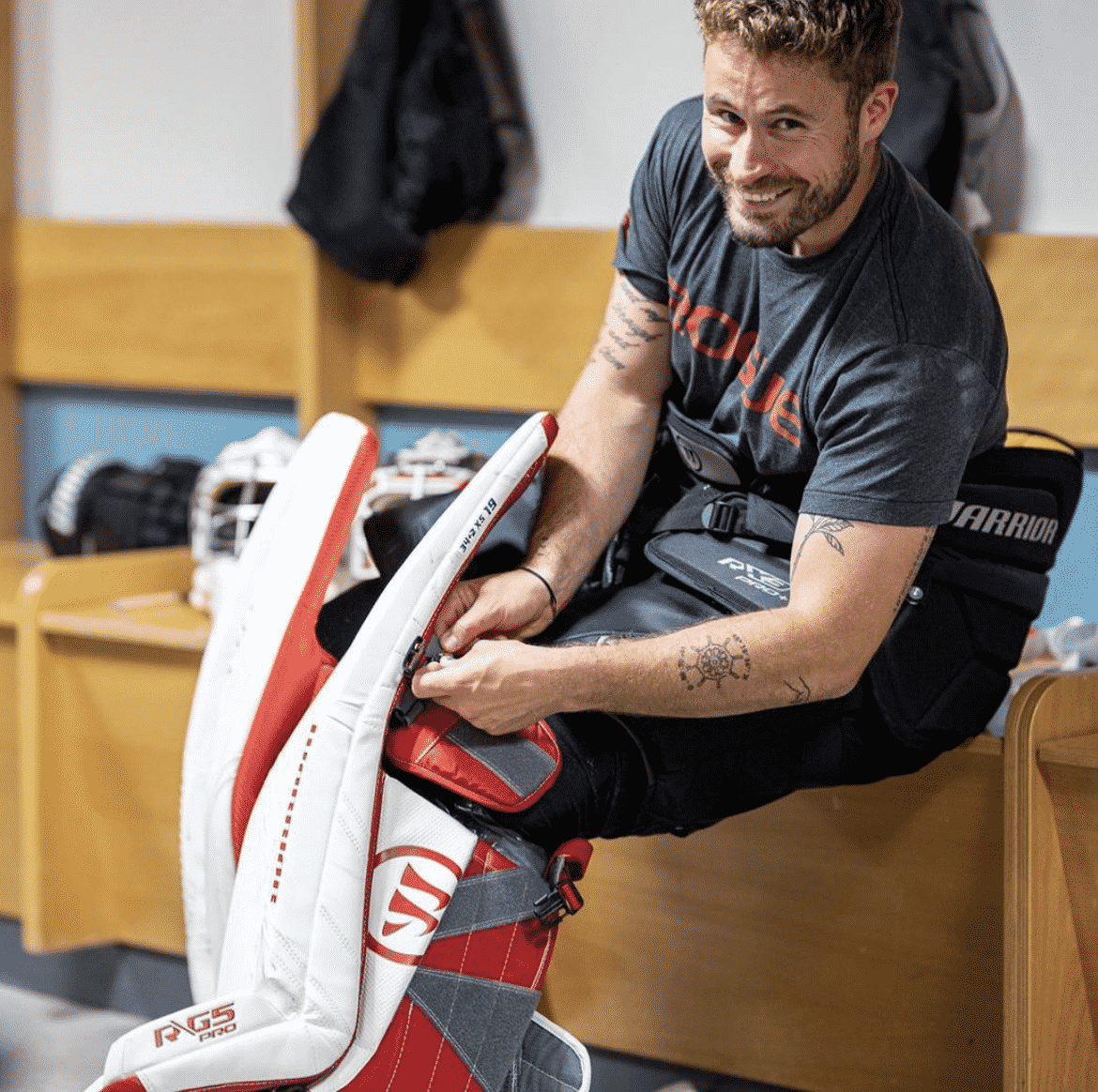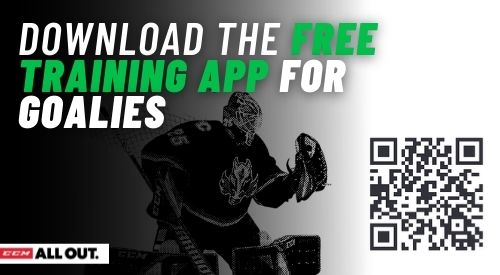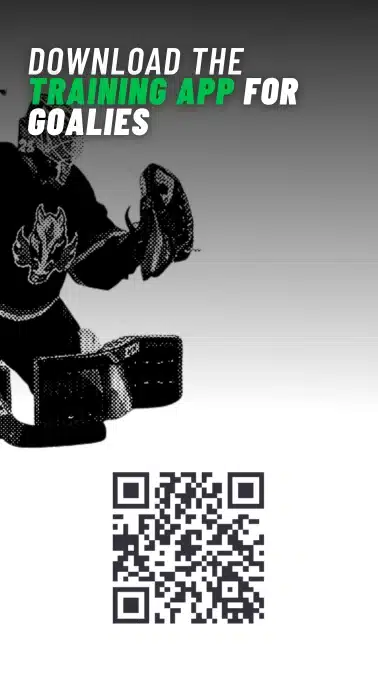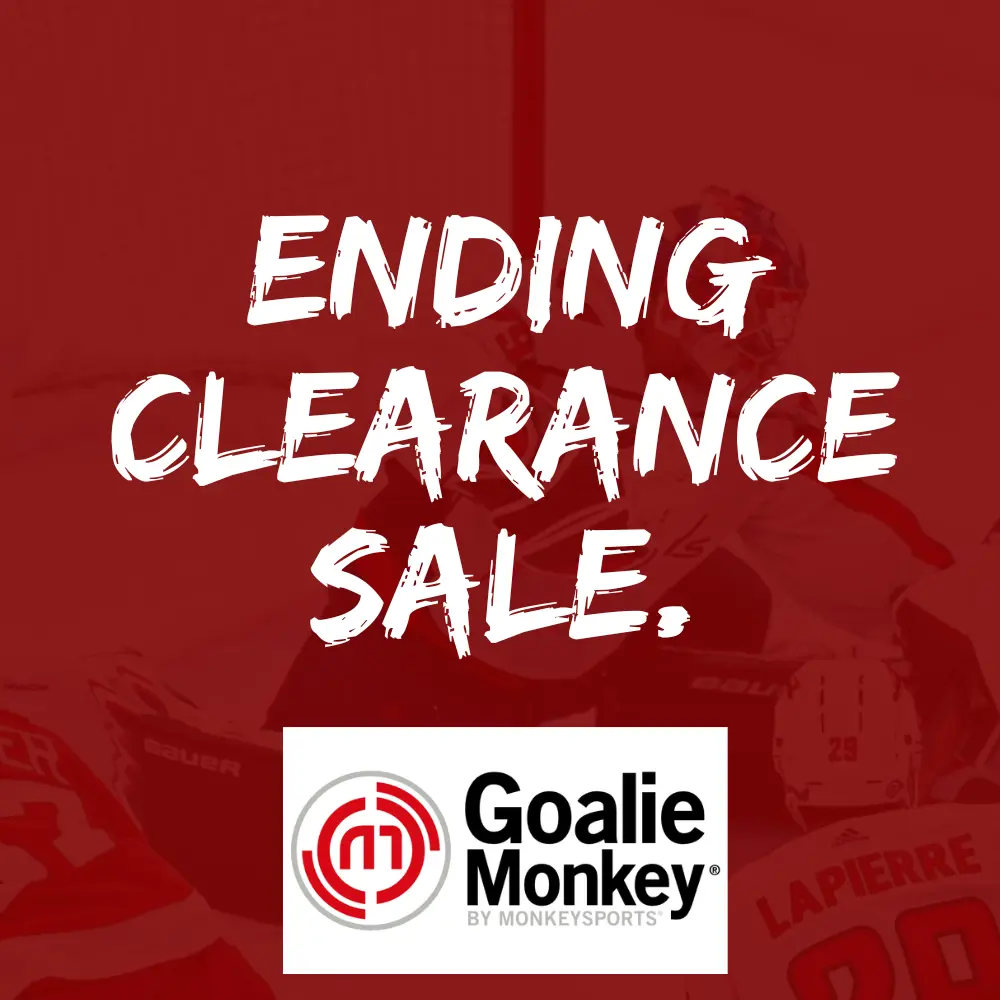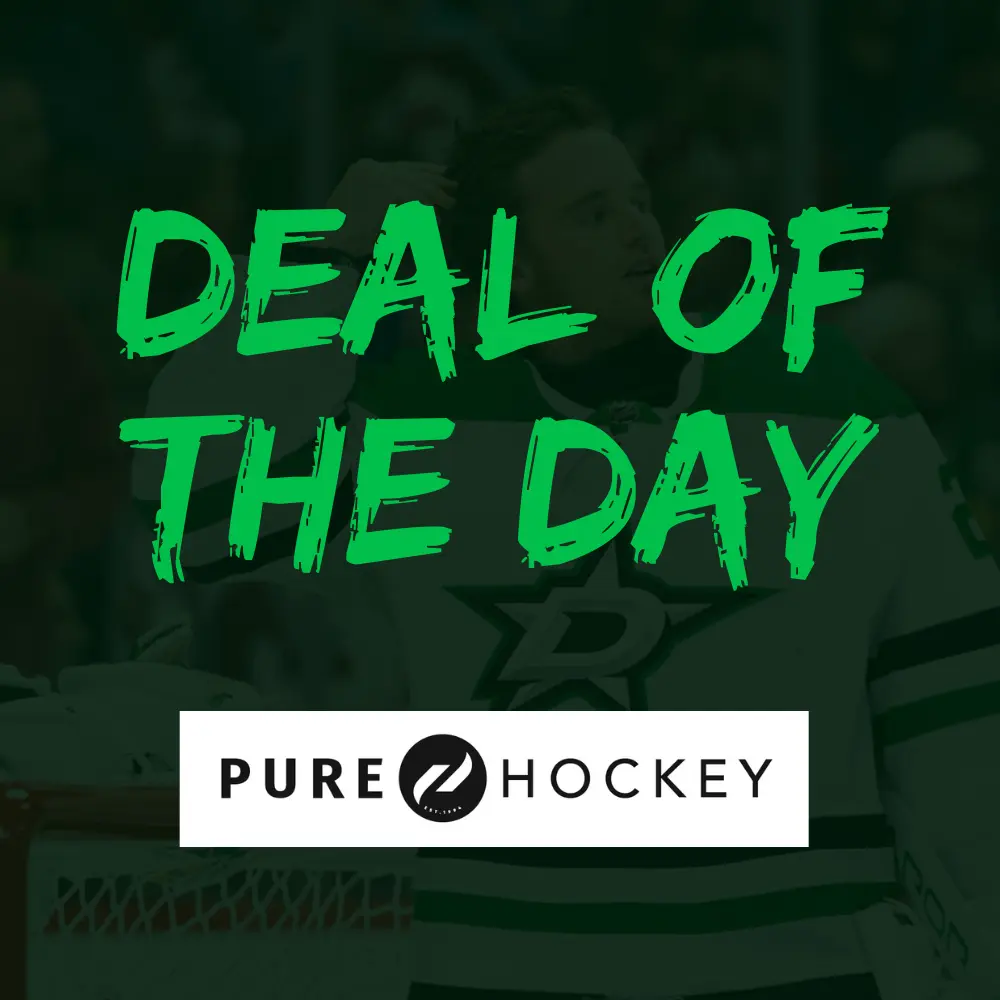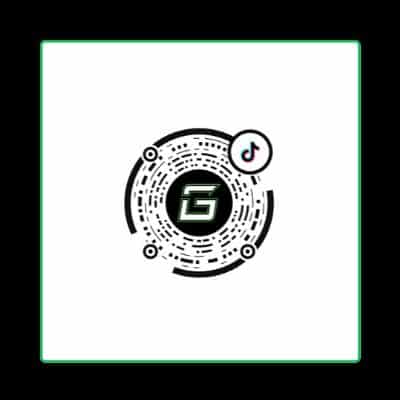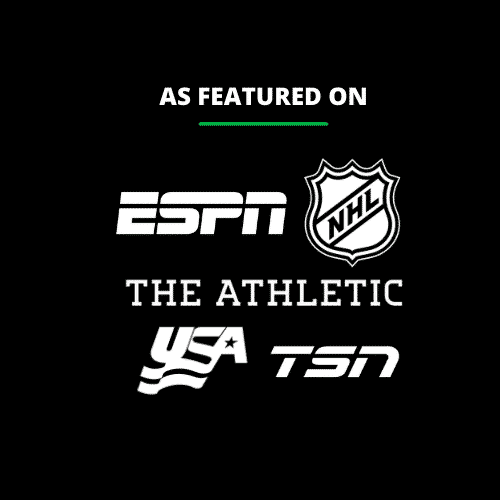Of any position in hockey, goalies wear the most protective (and also most expensive) pieces of equipment. While many question the sanity of a person who willingly puts themselves in the path of a puck shot at up to 100 miles per hour, goalies are actually very well protected and it’s a very safe position. If you’re a new goalie parent questioning your son or daughter’s decision, have no fear. Modern-day goalie equipment is highly protective, designed to ensure a fun and safe experience for everybody playing the position.
Becoming a goalie is one of the most exciting journeys you’ll embark on. You’re playing the single most physically demanding position in sports. At the same time, I can personally assure you that you will not find a position more enjoyable. From the ups of shutouts to the downs of giving up several goals in a row, playing goalie is one of the most rewarding things I’ve ever done.
With that being said, the goalie equipment list is extensive.
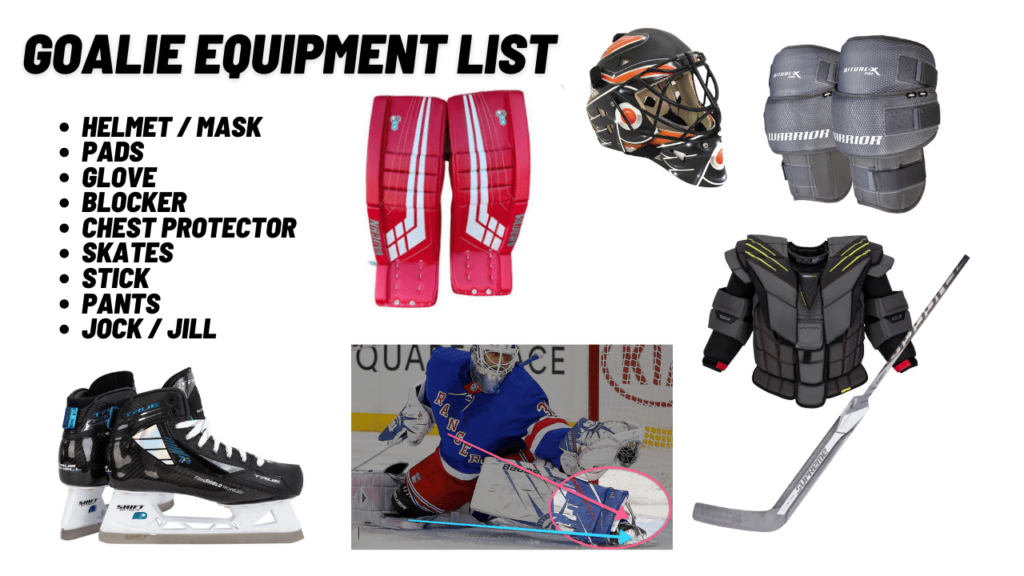
Here is every piece of equipment a hockey goalie wears.
If you’re just getting started playing goalie, you’re going to first want to determine your pad size. If you’re thinking about ordering custom goalie gear, you’re going to want to learn about the possible goalie gear specs prior to your order. For custom pad orders, researching some of the possible goalie pad modifications out there is a great idea prior to ordering your new gear. Modifications and stock or custom gear specs are the name of the game for goalies and their customized gear.
For those interested in ordering stock goalie gear, learning what specs are out there is a good idea, but not a requirement. Simply because a piece of gear is labeled as “stock” doesn’t mean it’s lower quality than customized gear. In fact, if you haven’t specifically used a gear spec you’re thinking about customizing, you probably should just stick with the stock option. Goalie pad manufacturers build pads as “stock” because the majority of goalies, including goalies at the NHL level, like the specifications. Stock specs, when it comes to goalie gear, mean they’re most likely to work for you.
The top two places to order new goalie gear are Goalie Monkey and Pure Goalie. This is due in large part to their superior return policies and the ability to order fully custom or stock gear.
What equipment do hockey goalies wear?
Goalies wear the most equipment of any sports position. Hockey goalie gear is also some of the most expensive. Goalies wear a helmet, throat protector, neck guard, chest protector, special padded goalie pants (that look like padded shorts), a glove, a blocker, a jock or jill, pads on their legs, skates, and use a thick goalie stick designed to protect the “5 Hole”.
Leg Pads
Leg pads are the pads that, you guessed it, go on your legs. There are six main brands of pads and goalie equipment; CCM, Bauer, Vaughn, Brians, True (Lefevre), and Warrior. All of these brands have different brands for different styles of play. If you are just getting into being a goalie, I would recommend going to a hockey store and checking out all the different types of pads they offer. There they will also size you up correctly to make sure that you get the best fitting pad possible.
Most commonly, goalies prefer to wear the same brand for their leg pads as well as glove and blocker. If there is any variation, typically, goalies will use a different catching glove than their pads, but this instance is generally rare.
Catching Glove
A catching glove is the glove that you wear that does not hold onto the stick. Whatever glove you catch with influences whether you use a right or left-handed stick. Most goalies catch with their left hand, which means they use a left-handed stick. Also, say you were a player before you wanted to make the switch to goalie, don’t worry what hand you shoot as much. I myself was a right-handed shot before I became a goalie, I catch with my left hand so I had to relearn how to shoot with a different hand stick. This is much easier than trying to learn how to catch with the opposite hand. Gloves come in different variations of angles and pockets, but these are mostly chosen by your personal preference.
Blocker
The blocker is the glove that you use to hold onto the stick. Blockers are very basic, where there is not much customization of the style that you wear. Most blockers are similar, I would just recommend that you chose one that matches your glove and leg pad’s design and model.
Stick
A stick is usually selected al on feel and play style. Many goalies use too long of a stick because they don’t have to bend down as far to make sure that their stick is on the ice. But too long of a stick can open up large holes when you go into the butterfly. On the flip side, if you have too short of a stick, you may have more control, but you will have a large five hole if you do not bend down to make sure your stick is flat on the ice.
Helmet
A good helmet is very important. In fact, if you use a non-HECC certified helmet, you will not be able to participate in any USA Hockey or Hockey Canada events. You must also use a certified cage on your certified helmet. There are three different types of cages, certified straight bar, certified cat-eye, and non-certified cat-eye. The reason you can not use non-certified cat-eye cages is because the eye holes are so big that a stick blade could slip through. For every helmet, you must also use a plastic neck protector. These neck protectors are either manually tied to the cage or helmet.
We’ve also written extensively about goalie helmet sizing, learn more in the linked article.
Skates
Goalie skates are very beneficial to use compared to regular player skates. Goalie skates have flatter designed blades that are more helpful when pushing around in the crease, and, they have better shot protection. Some goalie skates have a two-piece design where the boot protector/blade holder is removable and replaceable. Many new goalie skates now just have a one-piece design. The main skate brands are Bauer, CCM, and Graf. Each different model of skate is made for a different size or shape of foot.
Chest Protector
A chest protector is a one-piece protector that covers your arms and whole torso. A chest protector is very important if you are a beginner goalie. It is tough to learn how to use your gloves and leg pads so, at the beginning of your goaltending career, many pucks will hit you in the chest. If you have a very thin or too small chest protector, you will get hit in exposed or non-protected areas.
Pants/Breezers
Goalie pants are the pads that you wear around your waist and are the same length as a pair of shorts. Player pants are okay to use as a beginner but as you progress, you will want to invest in a pair of goalie pants because of the additional padding.
Jock/Jill
Jocks and jills are the pieces of equipment that protect your pelvis area. These pieces are very important because getting hit in the pelvis or privates can really injure you if you do not have proper protection. A player jock or jill will work but again, as you progress you will want to have more protection. Goalie jocks and jills offer protection to the pelvic bone, where player jocks and jills do not.
Knee Pads
Knee pads are not necessary to play goalie but they do protect your knees from being hit with pucks. Being hit in the knee does not feel good, trust me, it has happened to me many times; I don’t wear knee pads still just because it’s a comfortability thing. Knee pads are also known to help save your hips from getting destroyed (which has also happened to me, two hip surgeries at age 16) so I think that they would be a good investment.
Bag
Finding a good goalie bag is a challenge. If you are going to be a goalie, you are going to need a bigger bag; there is just much larger equipment. I recommend for beginners to get large wheel bags because it makes toting around a lot of equipment much easier. Especially for young goalies, nobody will judge a kid goalie for wheeling around his equipment, it will also take the load off of the parent from carrying the gear to and from the rink.
I hope that this guide was helpful in preparing to either start playing goalie, or getting someone else into the position. It truly is the best position in all of sports. If you got this far and we weren’t helpful, maybe you’re not in the market for new gear. Perhaps you should try cleaning yours?
Have a great day, all!
